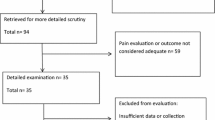Abstract
Purpose
To evaluate the successful rate and patient acceptance of different-sized hysteroscope in office hysteroscopy.
Methods
We retrospectively evaluated 900 office hysteroscopy performed in ambulatory setting using three different hysteroscopes: 5 mm Hamou II (n = 300), 5 mm Bettocchi (n = 300) and 4 mm Bettocchi (n = 300). Endpoints of our study were the successful rate of hysteroscopy, the eventual side effects/complication and the pain intensity experience from the patients using visual analog scale (VAS).
Results
Use of 4 mm Bettocchi leads to a higher rate of successfully performed hysteroscopy (99 %, n = 297) and statistically significant when compared to the 5 mm Hamou (95 %, n = 285) and to the 5 mm Bettocchi (96 %, n = 288) (4 mm Bettocchi vs. 5 mm Bettocchi p < 0.05; 4 mm Bettocchi vs. 5 mm Hamou II p < 0,001; 5 mm Bettocchi vs. 5 mm Hamou II ns). Moreover, the VAS score was higher using 5 mm Hamou II (5.72 ± 1.99) and statistically significant when compared to the 4 mm Bettocchi (3.06 ± 2.14) and to the 5 mm Bettocchi (4.27 ± 1.88) (A vs. B p < 0.05; A vs. C p < 0.001; B vs. C p < 0.001).
Conclusions
Our result suggests that the hysteroscope size plays a pivotal role in the acceptance and for the success of office hysteroscopy.



Similar content being viewed by others
References
Pluchino N, Ninni F, Angioni S, Artini P, Araujo VG, Massimetti G, Genazzani AR, Cela V (2010) Office vaginoscopic hysteroscopy in infertile women: effects of gynecologist experience, instrument size, and distention medium on patient discomfort. J Minim Invasive Gynecol 17:344–350
Campo R, Van BY, Rombauts L, Brosens I, Gordts S (1999) Office mini-hysteroscopy. Hum Reprod Update 5:73–81
Cicinelli E, Parisi C, Galantino P, Pinto V, Barba B, Schonauer S (2003) Reliability, feasibility, and safety of minihysteroscopy with a vaginoscopic approach: experience with 6,000 cases. Fertil Steril 80:199–202
Cooper NA, Smith P, Khan KS, Clark TJ (2010) Vaginoscopic approach to outpatient hysteroscopy: a systematic review of the effect on pain. BJOG 117:532–539
Bettocchi S, Nappi L, Ceci O, Selvaggi L (2004) Office hysteroscopy. Obstet Gynecol Clin North Am 31:641–654 (xi)
Valle RF (1999) Office hysteroscopy. Clin Obstet Gynecol 42:276–289
Pellicano M, Guida M, Zullo F, Lavitola G, Cirillo D, Nappi C (2003) Carbon dioxide versus normal saline as a uterine distension medium for diagnostic vaginoscopic hysteroscopy in infertile patients: a prospective, randomized, multicenter study. Fertil Steril 79:418–421
Shankar M, Davidson A, Taub N, Habiba M (2004) Randomised comparison of distension media for outpatient hysteroscopy. BJOG 111:57–62
Bettocchi S, Selvaggi L (1997) A vaginoscopic approach to reduce the pain of office hysteroscopy. J Am Assoc Gynecol Laparosc 4:255–258
Unfried G, Wieser F, Albrecht A, Kaider A, Nagele F (2001) Flexible versus rigid endoscopes for outpatient hysteroscopy: a prospective randomized clinical trial. Hum Reprod 16:168–171
Finikiotis G (1993) Side-effects and complications of outpatient hysteroscopy. Aust N Z J Obstet Gynaecol 33:61–62
Tangsiriswatthana T, Sangkomkamhang US, Lumbiganon P, Loapaiboon M (2009) Paracervical local anaesthesia for cervical dilation and uterine intervention. Cochrane Database Syst Rev (1). doi:10.1002/14651858.CD005056.pub2
Bracco PL, Vassallo AM, Armentano G (1996) Infectious complications of diagnostic hysteroscopy. Minerva Ginecol 48:293–298
Kasius JC, Broekmans FJ, Fauser BC, Devroey P, Fatemi HM (2011) Antibiotic prophylaxis for hysteroscopy evaluation of the uterine cavity. Fertil Steril 95:792–794
de Carvalho Schettini JA, Ramos de Amorim MM, Ribeiro Costa AA, Albuquerque Neto LC (2007) Pain evaluation in outpatients undergoing diagnostic anesthesia-free hysteroscopy in a teaching hospital: a cohort study. J Minim Invasive Gynecol 14:729–735
Perez-Medina T, Bajo JM, Martinez-Cortes L, Castellanos P, Perez de Avila I (2000) Six thousand office diagnostic-operative hysteroscopies. Int J Gynaecol Obstet 71:33–38
Cicinelli E (2010) Hysteroscopy without anesthesia: review of recent literature. J Minim Invasive Gynecol 17:703–708
Nagele F, O’Connor H, Davies A, Badawy A, Mohamed H, Magos A (1996) 2500 outpatient diagnostic hysteroscopies. Obstet Gynecol 88:87–92
Brusco GF, Arena S, Angelini A (2003) Use of carbon dioxide versus normal saline for diagnostic hysteroscopy. Fertil Steril 79:993–997
Bettocchi S, Ceci O, Di VR, Pansini MV, Pellegrino A, Marello F, Nappi L (2002) Advanced operative office hysteroscopy without anaesthesia: analysis of 501 cases treated with a 5 Fr. bipolar electrode. Hum Reprod 17:2435–2438
Porreca MR, Pansini N, Bettocchi S, Loverro G, Selvaggi L (1996) Hysteroscopic polypectomy in the office without anesthesia. J Am Assoc Gynecol Laparosc 3:S40
Bettocchi S, Ceci O, Nappi L, Di VR, Masciopinto V, Pansini V, Pinto L, Santoro A, Cormio G (2004) Operative office hysteroscopy without anesthesia: analysis of 4863 cases performed with mechanical instruments. J Am Assoc Gynecol Laparosc 11:59–61
Conflict of interest
None.
Author information
Authors and Affiliations
Corresponding author
Additional information
F. Romani and M. Guido equally contributed to this work.
L. Selvaggi and A. Lanzone share equal seniorship.
Rights and permissions
About this article
Cite this article
Romani, F., Guido, M., Morciano, A. et al. The use of different size-hysteroscope in office hysteroscopy: our experience. Arch Gynecol Obstet 288, 1355–1359 (2013). https://doi.org/10.1007/s00404-013-2932-7
Received:
Accepted:
Published:
Issue Date:
DOI: https://doi.org/10.1007/s00404-013-2932-7




